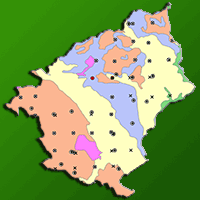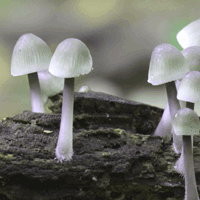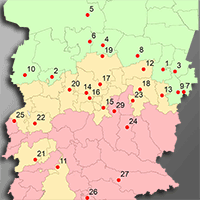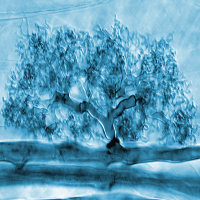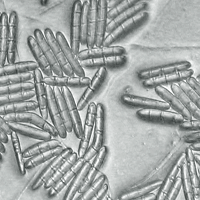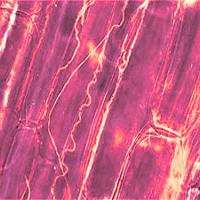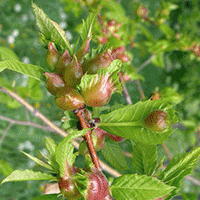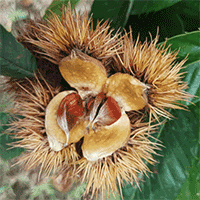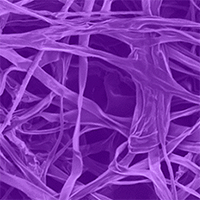
Secondary metabolites of six Siberian and Crimean Armillaria species and their in vitro phytotoxicity to pine, larch and poplar
Tatyana V Antipova (1) , Valentina P Zhelifonova (1), Yulia A Litovka (2-3), Igor N Pavlov (2-3), Boris P Baskunov (1), Zhanna A Kokh (2-4), Polina V Makolova (2-3), Anton A Timofeev (2), Anatoly G Kozlovsky (1)
iForest - Biogeosciences and Forestry, Volume 15, Issue 1, Pages 38-46 (2022)
doi: https://doi.org/10.3832/ifor3840-014
Published: Feb 04, 2022 - Copyright © 2022 SISEF
Research Articles
Abstract
Basidiomycetes Armillaria infect deciduous, coniferous and fruit trees, causing enormous economic damage. The role of secondary metabolites (tricyclic sesquiterpene aryl esters - melleolides) in the life cycle and pathogenesis of Armillaria is under active investigation. To date, not all species of Armillaria have been tested for the biosynthesis of melleolides. We investigated the secondary metabolite profiles of six root-pathogenic species of the genus Armillaria (A. borealis Marxmüller & Korhonen, A. cepistipes Velenovský, A. gallica Marxm, A. mellea (Vahl) P. Kummer, A. sinapina Bérubé & Dessur, A. ostoyae (Romagn.) Herink) distributed in Siberia (South Krasnoyarsk Krai, Republic of Tyva, Republic of Khakassia, Taimyr Peninsula), Russian Far East (Sikhote-Alin) and Crimea (Krymsky National Park, Chatyr-Dag Mountain Lower Plateau). A total of 15 compounds were identified in the metabolome profile. Two compounds (melleolide D and melledonal C) are synthesized by all investigated strains irrespective of their geographic location and host plant. The maximum spectrum of melleolides (7-8 compounds) was found in isolates of A. borealis, A. gallica, A. sinapina, A. ostoyae. In submerged culture, the maximum accumulation of melleolides varied from 2 up to 239 mg l-1. A mixture of melleolide D and melledonal C (1:1) synthesized by the most productive strain A. mellea Cr2-17 was first found to have a phytotoxic action on the growth parameters of the callus culture Populus balsamifera and 10-day-old conifer seedlings. A 0.5% concentration of melleolides caused a credible decrease of P. balsamifera callus raw biomass; a decrease of the viability of Larix sibirica and, which is especially significant, Pinus sylvestris seedlings; inhibition of stem and root growth processes; dechromation of foliage; loss of turgor. The occurrence of a broad range of melleolides in the metabolome profile and two common compounds in all investigated strains, with a phytotoxic action at their sufficiently high concentration, enables considering the synthesis of melleolides by Armillaria fungi as one of the possible mechanisms of their pathogenicity efficiently realized in strains characterized by overproduction of melleolides under natural conditions.
Keywords
Melleolides, Metabolome, Armillaria fungi, Phytotoxicity, Callus, Coniferous Plants
Authors’ Info
Authors’ address
Valentina P Zhelifonova 0000-0001-9213-9584
Boris P Baskunov 0000-0002-0342-2431
Anatoly G Kozlovsky
GK Skryabin Institute of Biochemistry and Physiology of Microorganisms, FRC Pushchino Centre for Biological Research, Russian Academy of Sciences, 5 Prosp. Nauki, Pushchino, Moscow Region, 142290 (Russia)
Igor N Pavlov 0000-0001-7312-0933
Zhanna A Kokh 0000-0003-4016-7596
Polina V Makolova
Anton A Timofeev
VN Sukachev Institute of Forest, FRC KSC, Siberian Branch, Russian Academy of Sciences, 50 Akademgorodok Str., Bld 28, Krasnoyarsk, 660036 (Russia)
Igor N Pavlov 0000-0001-7312-0933
Polina V Makolova
FSBEIHE MF Reshetnev Siberian State University of Science and Technology, 82 Prosp. Mira, Krasnoyarsk, 660037 (Russia)
FSBEIHE Krasnoyarsk State Agrarian University, 90 Prosp. Mira, Krasnoyarsk, 660049 (Russia)
Corresponding author
Paper Info
Citation
Antipova TV, Zhelifonova VP, Litovka YA, Pavlov IN, Baskunov BP, Kokh ZA, Makolova PV, Timofeev AA, Kozlovsky AG (2022). Secondary metabolites of six Siberian and Crimean Armillaria species and their in vitro phytotoxicity to pine, larch and poplar. iForest 15: 38-46. - doi: 10.3832/ifor3840-014
Academic Editor
Alberto Santini
Paper history
Received: Apr 06, 2021
Accepted: Dec 02, 2021
First online: Feb 04, 2022
Publication Date: Feb 28, 2022
Publication Time: 2.13 months
Copyright Information
© SISEF - The Italian Society of Silviculture and Forest Ecology 2022
Open Access
This article is distributed under the terms of the Creative Commons Attribution-Non Commercial 4.0 International (https://creativecommons.org/licenses/by-nc/4.0/), which permits unrestricted use, distribution, and reproduction in any medium, provided you give appropriate credit to the original author(s) and the source, provide a link to the Creative Commons license, and indicate if changes were made.
Web Metrics
Breakdown by View Type
Article Usage
Total Article Views: 30946
(from publication date up to now)
Breakdown by View Type
HTML Page Views: 26793
Abstract Page Views: 2011
PDF Downloads: 1663
Citation/Reference Downloads: 0
XML Downloads: 479
Web Metrics
Days since publication: 1409
Overall contacts: 30946
Avg. contacts per week: 153.74
Citation Metrics
Article Citations
Article citations are based on data periodically collected from the Clarivate Web of Science web site
(last update: Mar 2025)
Total number of cites (since 2022): 1
Average cites per year: 0.25
Publication Metrics
by Dimensions ©
Articles citing this article
List of the papers citing this article based on CrossRef Cited-by.
References
Scanning electron microscopy for fungal sample examination. In: “Laboratory Protocols in Fungal Biology: Current Methods in Fungal Biology” (Gupta VK, Tuohy MG, Ayyachamy M, Turner KM, O’Donovan A eds). Springer New York, New York, USA, pp. 133-150.
CrossRef | Gscholar
Higher edible basidiomycetes in pure culture. Naukova Dumka, Kiev, Ukraine, pp. 144. [in Russian]
Gscholar
Biology of higher plant cells in vitro and biotechnologies on their basis (study guide). FBK-Press, Moscow, Russia, pp. 160. [in Russian]
Gscholar
Geographical distribution and ecology of the Armillaria species in western Europe. Forest Pathology 23 (6-7): 321-341.
CrossRef | Gscholar
Tissue culture methods in plant physiology and biochemistry. Naukova Dumka, Kiev, Ukraine, pp. 488. [in Russian]
Gscholar
Benomyl-malt agar for the purification of cultures of wood decay fungi. Plant Disease Reporter 58: 902-904.
Gscholar
Basics of biotechnology: cultivation of isolated plant cells and tissues (study guide). ESSTU, Ulan-Ude, Russia, pp. 58. [in Russian]
Gscholar

